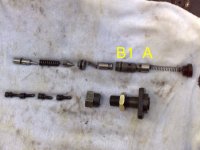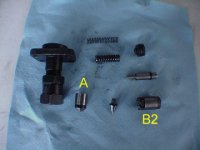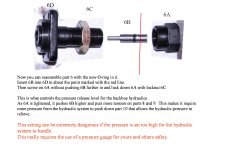Yes, that would work, provided you have the metric adapter to screw into the Metric "O" ring face seal hose end. I have not been able to find any adapters compatible with this type fitting on this side of the ponds. An easier way to find adapters for is if you put the gauge onto a port at teh control valve body. On my HW-03 backhoe the outlet ports to the cylinder hoses use a straight metric adapter to a metric "O" ring face seal fitting. The hose end is ORFS and screws onto this adapter. I can get straight metric to NPT or AN type fittings at my local hydraulic shop.
As for procedure, pick a working port on the valve, or a cylnder end of a hose if you have the adapters. Figure out exactly which backhoe cylinder it feeds and make sure that backhoe structure is physically supported. IE: if you remove the boom up/down line and the boom is not supported, it may head for the ground pretty quickly and crush or maim anything in it's way

It will also spray fluid from the fitting you just disconnected, so a good rule when working around hydraulics is to wear safety glasses. Once supported, work the control levers to make sure no pressure is present in that circuit. Once the pressure is off, remove the hose end(don't loose the "O" ring or fiber sealing washer) from the cylinder or from the valve body adapter. If working at teh valve body, then remove the adapter itself. The adapter should have a "O" ring and perhaps a washer at it's base, again, don't loose these

Screw in your metric adapter that is compatible with your gauge, and the gauge into the adapter.
The hose end you removed, should go into a bucket in case you operate the lever for the circuit you are working with in the wrong direction. If this happens, the cylinder will move, and fluid will come out of that hose end(don't ask me how I know this

). IF you are working at teh cylinder end, cover the port with a rag and put a bucket underneath the cylinder port. Start up the tractor, engage the backhoe pump drive and move the appropriate lever to send fluid to the port or hose end that the gauge is screwed into. Since the fluid has no where to flow, the pressure will quickly build to the point that the relief valve opens. The pressure read on the gauge will be the pressure that the relief is set to open at and maintain.
Another option which I did for my BH is to modify an adapter that will screw down into the plug that holds down the spring for the check valve ball. When seated at your backhoe, there should be a round slotted screw head plug to the left side of the valve. This plug is directly over the relief valve assembly which is on the bottom left end of the valve block. You can modift an adapter to the same dimensions as this plug and put it in place of hte plug, and screw the gauge down into the adapter. This worked well for me to check system/relief pressure. IF you like, I have some diagrams of the adapter I modified, but it requires a little machine work with a lathe to make one out of a standard metric adapter.
Good Luck



